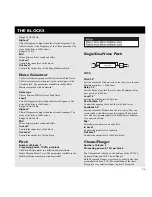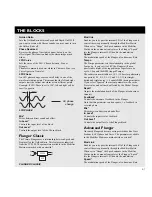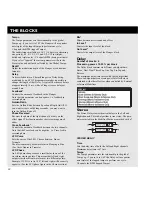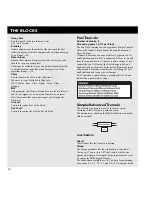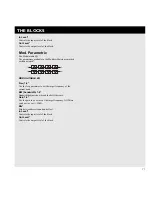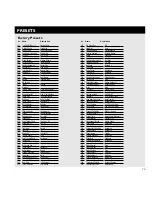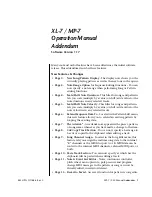
66
THE BLOCKS
Trig (Start/Stop)*
Sets the action carried out when Reverse is triggered via the
Modifier Matrix. To change the playback state of the Reverse
Delay the control value must come from the opposite state.
Stop/Play -Will Stop Reverse playback when the control
value is below 45%, and Play Reverse delay
when the control value is above 55%.
Restart - Will restart Reverse playback when the control
value is above 55%.
Mix*
Mixes between direct sound and effect.
In Level*
Controls the input level of the block.
Out Level*
Controls the output level of the Delay block
Try morphing a vocal signal from plain language to
reversed nonsense by increasing Grade from
0-100%.
Advanced Reverb
Number of blocks: 1
Processing power: 39-44% per block
The Reverb in the FireworX is based on the heritage of the
M5000 and M2000, and is tuned for studio use.
REVERB
The Reverb section of the FireworX can create a variety of
Reverb effects including the feature of emulating the initial
reflections of a room which creates some mind blowing
spatial effects until now only available in the TC M5000.
When using the FireworX Reverb, you should see the Reverb
as two parts:
1. Initial room reflections
2. The Decay
The initial room reflections are, depending on the size of the
room, the first 50-200 ms of the Reverb and it is these
reflections that contain the information of the size and shape
of a room and create the width and most of the depth
experienced in a real hall or room.
The Decay is the later part of a natural reverb which is
experienced as prolonging the sound and creating some depth
behind the source or direct signal, but integrating it in the
spatial characteristics of the hall or room, like you experience
in natural ambience or reverb.
By emulating initial room reflections, the FireworX can
create some very deep and wide stereo images, placing the
source or direct signal in the hall/room without using long
decay times - (which often makes the sound image very
“crowded” and disturbs your mix).
To check out what the initial reflections can do, reduce or
turn down the Decay level in the Decay parameters section
and turn up Room level in the Room parameters section.
Then change the Room size and the Room shape in the
Master section and choose the combination that you like.
Then change the Color in the Room parameters section to
find the tonal balance that suits you.
You will hear a short spatial reverb which sounds a little like
a “gated “ reverb. Then at last add the decay by turning up
the Decay level in the Decay parameters section and select
the decay time that you prefer.
You will also hear that you are able to create a very spatially
wide and deep stereo reverb with a relatively short and low
level decay.
When listening to the Reverb’s initial reflections alone at a
high level and when selecting Room size XL, you might get
a “slapback” effect, but by adding the right length and
amount of decay and by balancing the Room level you will
find that it will be transformed into width and depth.
Square: A typical square room with its defined
reflection patterns.
Round: A diffuse room with lively reflections.
Curved: A soft, yet still defined set of reflections.
Summary of Contents for FirewarX
Page 1: ...FireworX STUDIO EFFECTS PROCESSOR USERS MANUAL ...
Page 2: ......








